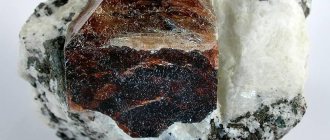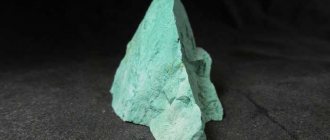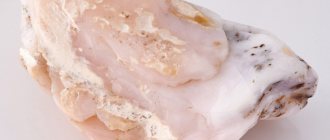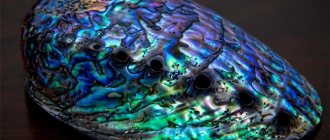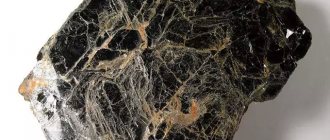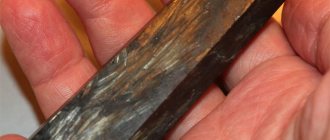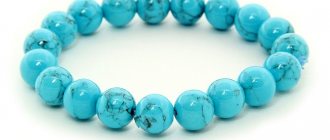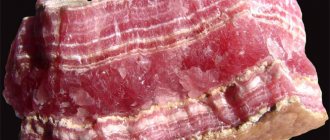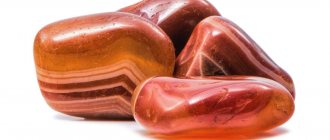What is this chemical element?
Zirconium is part of zircon. Some mineralogists believe that it received its name from its “parent”. And another group of scientists claims that the concept of zirconium goes back to the Arabic language. It can be translated as "cinnabar" or silver color.
Zirconium is considered a trace element because it does not occur separately in the natural environment. In nature, geologists find it as silicate or oxide. The existence of zirconium was proven at the beginning of the 18th century by Berzelius, a chemist from Sweden. The atomic number of zirconium is 40. The chemical element in the table is designated by the symbol Zr (Latin name Zirconium). Cinnabar as a metal was obtained at the beginning of the 20th century in laboratory conditions from zircon. It consists of silver-white rods.
Amulets and talismans
The use of amulets and talismans dates back to ancient times. It has long been noted that zirconium products have magical and healing powers.
It can be assumed that the magical and healing properties of zircons are associated specifically with radiation. It cannot be ruled out that with the help of these stones or magic balls made from varieties of zircon, magicians influenced the will of people. Zirconium is the stone of priests and rulers. The Grand Master of one of the Masonic orders is required to wear a ring with a zircon on his finger.
Metal properties
Synthetically produced zirconium is a silvery-white metal. The appearance of cinnabar is similar to steel. The metal has unique properties that no other natural formation has.
Physical
Cinnabar has the following physical properties:
- thermal conductivity - 23.86 W/(m x K);
- boiling point approximately 4350 °C;
- elastic modulus – 95–97 GPa;
- rigidity – about 600–1700 MPa;
- ability to withstand heating up to 2600 ˚C without deformation;
- density 6.5-10 g per cm3.
Silver-colored metal also has plasticity; it can melt in a vacuum and in inert gases.
Chemical
The most important chemical property of zirconium is its high resistance to corrosion even when exposed to acids and alkalis. But this ability decreases when exposed to high temperatures. Silver-colored metal can also form alloys with other chemical elements.
Biological
Cinnabar also has biological properties. It has a huge positive effect on the human body. The good functioning of some organs depends on zirconium, because it is a bioelement and is included in the structure of their cells. These data were obtained by domestic physiologists quite recently during additional studies of the chemical element. All the positive qualities of zirconium are being studied gradually, and new facts about the silver-colored metal become known almost every year.
Many leading clinics specializing in maxillofacial surgery and traumatology use the latest method. It involves the use of special fixators for multiple bone fractures. These devices hold the fragments together and prevent movement of parts of the bone. This promotes faster tissue fusion, hence faster healing of fractures. These retainers are made from zirconium. Also, alloys of titanium, stainless steel, and cinnabar are used to create various screws, staples, plates, and fasteners, which are used in surgery and even during operations on the brain and spinal cord.
Implants made from cinnabar alloys have many advantages over other materials:
- the ability not to rust even in an aggressive, acidic environment;
- high biological compatibility with any tissue of the human body;
- absence of allergic reactions when cells interact with zirconium objects;
- excellent strength of the clamps, despite the fact that their design is often simple.
Due to their unique structure, alloys have a low density, so products made from them have a lightweight weight. This quality is also valuable in the manufacture of retainers. To all of the above, we can add that the plasticity of silver-colored metal allows you to create devices that fully correspond to the contour of the damaged bone.
Cinnabar does not irritate the surrounding soft and inert tissues, but on the contrary has a beneficial effect on them. Doctors have found that zirconium earrings (put in immediately after the mini-surgery) promote rapid healing of wounds on the earlobes after piercing. The process goes much faster than when wearing gold items.
If you constantly wear jewelry made of silver metal, you will soon notice an improvement in your general physical condition. And weather-dependent people stop reacting sharply to temperature changes and magnetic storms. Doctors have already experimentally established that zirconium products have the following medicinal properties:
- bracelets relieve irritation due to skin diseases and stabilize blood pressure;
- belts help in the treatment of diseases of the musculoskeletal system;
- plates that are applied to joints relieve pain in arthrosis and arthritis.
Even when making dental prosthetics, experienced dentists recommend choosing materials made from cinnabar.
But do not forget that zirconium products are not a panacea for all diseases. You must follow all your doctor’s orders and take your medications. And cinnabar will enhance the effect of traditional medicine.
Place of Birth
The top three countries in terms of raw material reserves are Australia, South Africa, and Russia. Large massifs of the rock are located in Brazil, the USA, and India.
Russia accounts for a tenth of global reserves:
- Most are concentrated in the European part (Murmansk, Tambov, Nizhny Novgorod regions).
- Beyond the Urals these are the Tomsk and Chita regions.
- An inexhaustible reserve is represented by the Khibiny syenites on the Kola Peninsula.
In the USA and Madagascar, samples of zircon of jewelry or collection grade are found. In the Khibiny there are eudialytes.
Production methods
The raw material for the industrial production of silver-colored metal was the mineral zircon. First, the mineral goes through the stage of enrichment using the gravitational method, combined with ore purification by separation (electrostatic and magnetic). This process involves sintering the concentrate with lime, calcium carbonate, and soda at high temperatures. Then remove silicon compounds from the sinter. Further decomposition with hydrochloric or sulfuric acid, obtaining zirconium from acidic solutions.
There are other ways to obtain cinnabar from zircon ores, but they are unprofitable due to their high cost.
Main features
If we consider natural conditions, then zirconium can be found exclusively in the form of oxide or silicate. Among all, the most popular are Ivdelites and Vodolites. Zirconium and hafnium have almost identical crystal lattice. Most zirconium mineral is found in the lithosphere. One ton of earth contains approximately 200 g of this element.
If you look at sea water and analyze its composition, you can also find compounds with zirconium. But there is much less of it there than in the ground. Among the leaders in terms of the number of gemstone deposits are:
- Australia;
- America;
- Brazil;
- India.
Most of the stone is mined in America. The metal was obtained through growth, due to which zirconium was formed from oxides.
Receipt methods
Zirconium strips are mounted on a hot tungsten filament. Under the influence of high temperatures above 1800 C, this strip sticks to the heater, and the remaining substances burn out. After some time, this method ceased to be used, because experts came to the conclusion that it was uneconomical, so they developed the Kroll method. During its use, zirconium dioxide is pre-chlorinated and then reduced with magnesium. There are some other ways to get this gemstone. It is also obtained from the oxide by alkaline and secondary routes.
Applications of zirconium
Silver-colored metal is used in various manufacturing industries.
- Electrical engineering. Ultra-strong conductors are made from an alloy of zirconium and niobium that can withstand enormous loads. Electronic circuit boards are also coated with cinnabar.
- Nuclear energy. Spare parts are coated with zirconium, from which mechanisms for thermonuclear reactors are subsequently assembled.
- Metallurgy. The metal is used to make parts of steel furnaces that can withstand temperatures of a thousand units.
- Mechanical engineering. Zirconium is becoming a material for creating pumps and fittings that operate in aggressive, acidic environments.
- Pyrotechnics. Fireworks and fireworks using cinnabar emit a significant amount of light energy with virtually no smoke.
- Chemical industry. Zirconium becomes the raw material for metal-ceramic coatings, which have high wear resistance and immunity to acids.
- Optics. The newest lenses are made from cubic zirconia - a material consisting of zirconium processed using a special technology with the addition of rare earth metals.
- Military industry. Cinnabar is used as a filler for flares and tracer bullets.
Silver-colored metal is used in medicine, as described in detail above. And also in the manufacture of exclusive tableware, which is quite expensive. But it has excellent hygienic properties. World-famous fashion designers create original fabrics that have moisture-repellent properties. It turns out that it is provided by zirconium salts that are part of the emulsion with which the material is impregnated. Cinnabar is used in the manufacture of some printing inks and special varnishes.
Zirconium has found its application both in large-scale industrial production and in small workshops in which craftsmen create designer items.
When should it be used?
The indications for the use of zirconium for treatment have not yet been established, although it is indispensable as an excellent material for medical instruments and implants.
This metal is used in chemical engineering as a corrosion-resistant material. Its additives deoxidize steel and also remove sulfur and nitrogen from it. Powdered zirconium is used in the production of ammunition and in pyrotechnics. Zirconium sulfate is a tanning agent that is widely used in the leather industry.
Minerals containing zirconium
Mineralogists are familiar with minerals containing cinnabar:
- Baddeleyite (zirconium oxide). It is used as an additive during the manufacture of refractory ceramics. The mineral also becomes a material for creating artificial diamonds.
- Eudialyte (zirconosilicate). This ore is suitable for the production of rare earth metals and zirconium.
No minerals containing zirconium have yet been discovered in nature. More recently, it was found that sea water also contains zirconium compounds. But scientists have not yet learned how to isolate metal from liquid.
How to distinguish a fake from a real zircon?
The analysis of precious stones and metals is carried out in the gemological center. The presence of a certificate from this organization serves as a guarantee of the authenticity of jewelry materials. Jewelers purchasing stones for their work may have such a document. But how can you understand that the product you are purchasing is made of the material named in the certificate, and that it corresponds to the stated price?
It's no secret that some unscrupulous jewelers often pass off cubic zirconia as natural diamonds and zircons, and sell cut zircons as diamonds. Transparent zircons are very rare, and they are not much cheaper than diamonds, so they are rarely passed off as the “king of stones”. But cubic zirconia in this regard is an excellent material.
It is only at first glance that the stones are absolutely identical. If you look closely, you can see inclusions and voids in the zircon. Unlike diamond and cubic zirconia, even the most transparent zircon has a yellowish-golden hue due to these formations. That is why in Persia it was called golden. Cubic zirconia has an even structure and even shine. In contrast, zircon has a low density and, accordingly, lighter weight.
Natural stones containing zirconium are mostly radioactive. For example, green zircons and black eudialytes should not be worn on the chest or neck. Earrings made from these stones can also pose a health hazard.
Transparent and golden zircon has minimal radioactivity, but the device senses it and can indicate it as a difference from “zero” cubic zirconia.
Cost per gram
The Commonwealth of Australia and the Republic of South Africa have long been the main suppliers of zirconium to the world market. The demand for metal is constantly increasing. And the amount of supplied material remains approximately at the same level. Therefore, its cost is constantly increasing.
At the moment, the price of a gram of cinnabar is about 100-200 rubles.
Zirconium has been known to human society for a century, but it still has not revealed all its secrets to people. It is unclear why the chemical element got its name, or what the full effect of the metal on a living organism is. Probably not all sulfurs are known in which this amazing silver-colored metal can be used.
Statistical data
Thus, this procedure is very important for any state, including Russia - the production of zirconium. Its manufacturing technology is complex, but its release is in any case more than justified. At the moment, zirconium is the only rare metal whose production and consumption volumes amount to hundreds of thousands of tons. Russia ranks fourth in the world in terms of its reserves. Structurally and qualitatively, the zirconium raw material base in our country is very different from foreign ones. More than 50% of ore reserves of this group in the Russian Federation are associated with alkali granites, 35% with zircon-rutile-ilmenite placers and 14% with baddeleyite kamaphorites. Abroad, almost all reserves of such minerals are concentrated in coastal and marine zones.
Impact on humans
Zirconium is not synthesized by biological organisms, but can be ingested from the air or with food.
Biological effects
The metal has found medical use in the following qualities:
- Antiseptic – stimulates wound healing, protects against infections and putrefaction.
- Antiallergen – smoothes out the manifestations of allergies.
- Radiation protection.
Healers claim that metal earrings heal skin, hypertension, arthrosis, and arthritis.
Deficiency/excess
It is impossible to “poison” zirconium from food: it is contained in microdoses.
Exposure to metal dust among workers at metallurgical and mining enterprises can be dangerous.
Symptoms of intoxication:
- Skin irritation.
- Pneumonia.
- Lung diseases.
The metal accumulates in soft tissues. The course of treatment includes measures to intoxicate the body.
Nutrition
Lamb, nuts (nutmeg, pistachios), and legumes are saturated with zirconium. It is found in chili peppers, vegetable oils, and cereals (oatmeal, rice, millet).
Every day a person needs 350 - 750 mcg of the element, depending on age and body weight.
